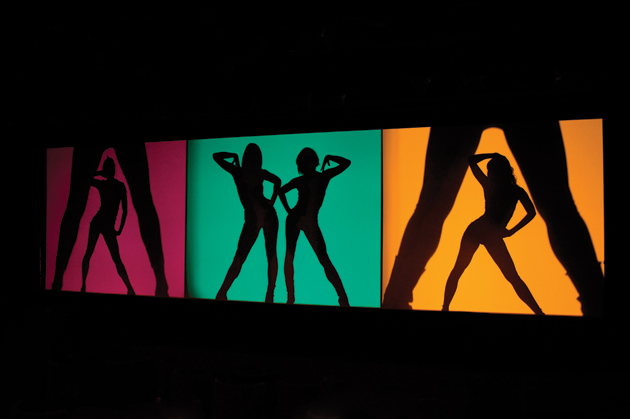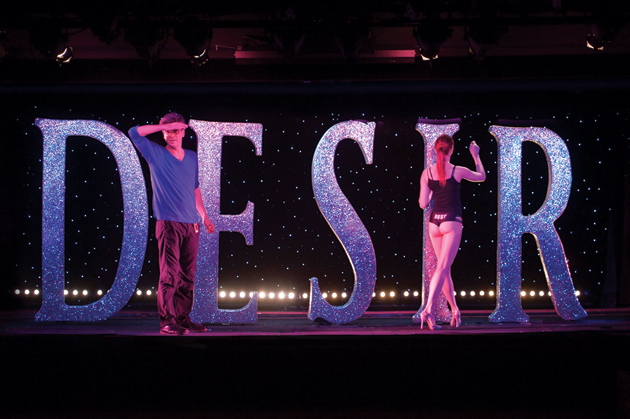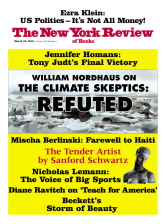Crazy Horse—an inside look at the celebrated Crazy Horse Saloon in Paris—is the thirty-ninth film that Frederick Wiseman has made since he established himself in 1967 with the devastating Titicut Follies, about life in a mental hospital in Massachusetts. Aside from two fiction films, these are all documentaries, ranging in length from seventy-five minutes to six hours—documentaries in a mode particular to Wiseman, who is not fond of the term “documentary” and has emphasized the relation of his films to the methods of fiction. They have no narration or explanatory subtitles; the filmmaker asks no direct questions of the people he films; the order in which scenes are presented is not necessarily chronological. The films concern themselves not with sharply demarcated events or with the doings of a selected individual but with places and institutions—places as institutions, institutions as places—and take whatever might occur within their limits as a legitimate object of attention.
This is not to say that they lack narrative; on the contrary they overflow with stories of every imaginable variety, whether witnessed, recounted, or surmised. If all Wiseman’s films together might be taken as a single ongoing work, any one of them contains at the same time multitudes of other potential films. A single shot or brief interjected phrase often serves as ideogram for a further range of associations. Think of it as an Arabian Nights constructed entirely out of pieces of the real world.
Wiseman professes to dislike talking about his work but he has written a brief and dense account of it called “A Sketch of a Life” in which he manages to head off what are doubtless frequently asked questions about his life, influences, methods, and aesthetic philosophy.1 Notably, he opens by quoting a passage from Alice’s Adventures in Wonderland—the caterpillar asking “Who are you?”—and characterizes himself at the outset as a “fantasist.” He describes his discovery of the close reading of poetry as having been fundamental in the development of his work, and at another point writes of how his mother, a frustrated actress, initiated him into the idea of theater by recreating down to the least word and gesture the activities of everyone she encountered in the course of a day. The implied concerns—the elusiveness of personal identity, the rigors and perils of verbal definition, the radiant variety of human behavior even in its smallest elements—illuminate but can hardly explain the process by which he arrived at the consistent method that has generated his life’s work.
It is a method of immersion—with a minimum of advance study or preparation—in a spatially limited milieu, whether missile base or public park, ballet school or monastery, intensive care unit or primate research lab, high school or slaughterhouse, the Canal Zone or the state legislature of Idaho. Wiseman films over a period of weeks whatever captures his interest within that space, and then out of that footage he constructs, over a period of many months, a film. This process can be seen as a trebly affirmed exercise in artistic freedom. The subject can be practically anything; any aspect of that subject may be filmed; and the results are selected and combined at will, without hewing to any preconceived plot or message: “I try to approach the shooting with a clear but empty head…. It is only during the editing that I discover the themes and structure of the film.” Others make outlines and then film them. Wiseman describes a paradoxical reversal: first he films, then he decides what film is there to be made. Fundamental questions of significance and intent are uncovered last of all.
It is something a poet might well dream of: to have available in tangible form the sense impressions of experience, to look one’s fill at them and then to freely manipulate them, bound by no law but an instinct for what is fitting. Films that begin as close observations of highly structured human activities become occasions for extraordinarily unfettered contemplation, in which the viewer may learn to appreciate the full weight of Wiseman’s statement that “the formal aspects of the shot are of maximum importance to me.”
“Looking one’s fill” takes on a more precise connotation with Crazy Horse, where the object of contemplation is the most upscale of Parisian cabarets, the quintessence of nu chic. Since Wiseman’s films are all about looking at the world, it’s appropriate that he should film a world that is all about the business of getting people to look. The film’s original title was Désirs—the name of the new revue whose creation is at issue in the scenes we see—and it could indeed be described as a film about desire, even if that leaves open the question of whose desire, and for what. It could equally well be described as a film about theater; about France; about office politics; about art and commercialism; about female performers; about male impresarios; about esprit de corps; about making a living; about intense physical effort; about lighting effects and ice buckets and gloves; about the body; about bodies; about the objectification of showgirls and the glorification of showgirls; very obliquely, about showgirls, hardly at all except by implication about the audiences who come to look at them; finally and definitively a film about looking—and by that token just as definitively a film about showing.
Advertisement
A film about erotic spectacle is itself unavoidably an erotic spectacle. Back in the early 1960s there was a genre of European films with titles like Sexy Proibito that offered strings of perfunctorily photographed numbers from high-end strip clubs. Crazy Horse brought that to mind (as Wiseman’s films inevitably bring to mind a host of forgotten circumstances and connections) because it so freely offers the vicarious experience of a night at the Crazy Horse night club on the avenue George V, minus the champagne and the prices. At least half the film consists of the numbers themselves, and the fundamental alternation between “stage” and “real” lives suggests further nuances of realness and staginess, of simulation and mere being, in rehearsal or business meeting or press conference or audition, or the recording session where a performer fakes an orgasm for the soundtrack, or the rare and precious moments when the performers allow themselves a break.
In navigating from dressing room to rehearsal session to performance, Crazy Horse becomes among other things a backstage musical complete with vying egos—the scarcely repressed struggle for dominance between director Philippe Decouflé and artistic director Ali Mahdavi—and high-concept numbers that cannot help but evoke Betty Grable or Busby Berkeley (even if songs like “Baby Buns” and “Vous Êtes Toxique” do not quite measure up to “I Only Have Eyes for You” of 1934), not to mention the unrestrained burst of comic relief when dancers in the dressing room giggle wildly as they watch a montage of ballet stars falling down onstage.
The setting is archetypal: it is the temple of desire, the place where we want to see everything—and the place where we have already seen everything, the ancient strip club whose show has been running forever. We might be in the cabaret where Lola-Lola entranced Emil Jannings in The Blue Angel, the forbidden site where schoolboys peer through the windows—since every such place becomes, in imagination, the one and only place, whether disguised as the Folies Bergères, Minsky’s, the Las Vegas flesh palaces memorialized in Paul Verhoeven’s Showgirls, or the glitzless tavern in downtown Davenport, Iowa, where many decades ago I glimpsed through a bus window, scrawled on a placard in magic marker, the eternal haunting promise: “TONITE CINDY IS TOPLESS.”
Any one of those venues might have made the basis for a film, of course, but not this film. The Crazy Horse, as we are reminded at every moment, is also a most particular location; started in 1951, when Paris was still poor, it has a unique sense of history and cultural importance. An administrator worries about achieving “a classy premiere” that will appeal to intellectual critics, and discourses on the component of “imagination and frustration” in erotic fantasy; Mahdavi invokes Fassbinder and Michael Powell. This difference is part of Wiseman’s subject; he is attentive to the inner traditions of the house at all levels, and to the nuances of a culture that produced (in the same 1950s when the Crazy Horse was established) a quasi-philosophical treatise entitled Métaphysique du Strip-Tease.2
Erotic spectacle is refined at the Crazy Horse by being placed in an altogether separate sphere, almost abstract in its distance from any rowdiness or vulgarity. In their working lives the dancers resist any suggestion of sordidness; in a meeting with managing director Andrée Deissenberg, Decouflé complains—by way of explaining some difficulties he has had in perfecting a particular onstage maneuver—that they wear gloves in rehearsals to avoid touching each other in the numerous lesbian-themed numbers, a modesty he claims to find bizarre.
Decouflé is the outsider here, a dancer and choreographer with a long resumé brought in to revamp Le Crazy’s acts by the new ownership that took over in 2005, and most of the time we see him struggling to retain creative control in the face of scheduling pressures and implied differences of artistic vision. Modest and harried, he is a remarkably sympathetic figure who pleads for more time to nurture the development of the new revue and reluctantly accedes when the flashy and endlessly voluble Mahdavi is brought in, presumably to ensure that Decouflé’s aesthetics do not stray too far from the commercial imperatives of the club.
Advertisement
In line with Wiseman’s usual methods, none of this back story is spelled out in the film. We simply pick up every clue we can as to personality and motive, with that watchful attentiveness that Wiseman inculcates. More than anything else his films are revelations of character, and it would be worth seeing Crazy Horse solely for the press conference where Mahdavi goes on hyperbolically about his notions of eroticism and beauty and the significance of the Crazy Horse while Decouflé sits at his side just barely containing his discontent.
In the juxtaposition of the two we seem to be invited to compare two opposed artistic types, Mahdavi coming across as obsessive, self-absorbed, and potentially autocratic, Decouflé as open, self-deprecating, and quietly serious. The meeting between Decouflé and a group of dancers in which managerial issues—such as assigning responsibility for miscues in an earlier performance—are freely discussed becomes an instance of respectful teamwork, and a beautiful example of how much meaning Wiseman is able to get from what might seem brief and undramatic exchanges. It is in such scenes that we are drawn deep into a sense of the Crazy Horse as workplace, a sense that expands to include the workers who put bottles of champagne into ice buckets to be placed on each table, the man delicately trimming a red wig, the male dancer painting on an eyebrow.
The magic corporeality enacted for the spectators is brought down to the level of pure detail work, as a dresser explains to a dancer precisely how the light reflecting off her costume makes her buttocks look bony, a monologue that would seem merely technical if it were not for the affection and modesty with which the dresser displays her craft. The scene is made considerably more amusing by the dresser’s unsuccessful struggle, while she speaks, to slide an excessively clingy piece of lingerie off a mannequin.
The mechanism of desire becomes increasingly abstract as acts are broken down into ever smaller components of fabric and light and movement. Wiseman has referred to this as one of his most abstract films: “All my films are, but Crazy Horse is very, very abstract.”3 But there is nothing diagrammatic about the people out of whom the patterns are made. We watch Decouflé fine-tuning the gestures of dancers behind a screen in order to produce the sexy silhouettes that look very much like images from the title sequence of a 1960s spy thriller. The fabrication of shadows is a motif from the beginning: the film opens with a variety performer making a shadow puppet of the Devil, with the emphasis less on the image created than on the way the hands are positioned to create it.
Crazy Horse manages to achieve a kind of constant double image. When we watch the numbers we see both the fantasy and the labor that goes into simulating it—the dream body offered up to the clientele of the Crazy Horse and the actual body working very hard at every moment of the spectacle. The show exists almost apart from the performers; they merely play in it. With Wiseman’s two previous films, La Danse—Le Ballet de l’Opéra de Paris (2009) and Boxing Gym (2010), Crazy Horse might be seen as part of a trilogy on physical effort. Beyond any words spoken or any larger social structures implied, what we are given to do is contemplate bodies in difficult purposeful movement: these are “action films” in the true sense, in which bodies are emotionally expressive in themselves.
The dancers are at the center of everything and yet they are the most elusive presences in the film. We learn nothing of them; their words seem always to be caught in passing; unlike the directors and administrators they are not given to long discourses on the nature of art or eroticism. The brief and silent moments when Wiseman catches them in repose have a beauty—an essential privacy—that is worlds away from the public spectacle around which all these lives are clustered. Between the production numbers’ maxi-shock (to use a term brandished during one of the rehearsals)—an array of nudes in military parade gear harangued by an invisible drill sergeant, a dunescape constructed out of artfully lit buttocks, the full lineup of dancers draping themselves around giant glittering letters that spell out D-É-S-I-R—come Wiseman’s daylight intervals of downtime where nothing much is going on: a dancer stands idly in a passageway, sunlight illuminates an empty stairwell. They are the most voluptuous moments in the film. Finally there is nothing to do but look.
-
1
“A Sketch of a Life,” in Frederick Wiseman, edited by Joshua Siegel and Marie-Christine de Navacelle (Museum of Modern Art, 2010). ↩
-
2
Denys Chevalier, Métaphysique du Strip-Tease (Paris: Jean-Jacques Pauvert, 1960). ↩
-
3
Laetitia Mikles and Delphine Lévy, “Entretien avec Frederick Wiseman,” Positif, October 2011. ↩





